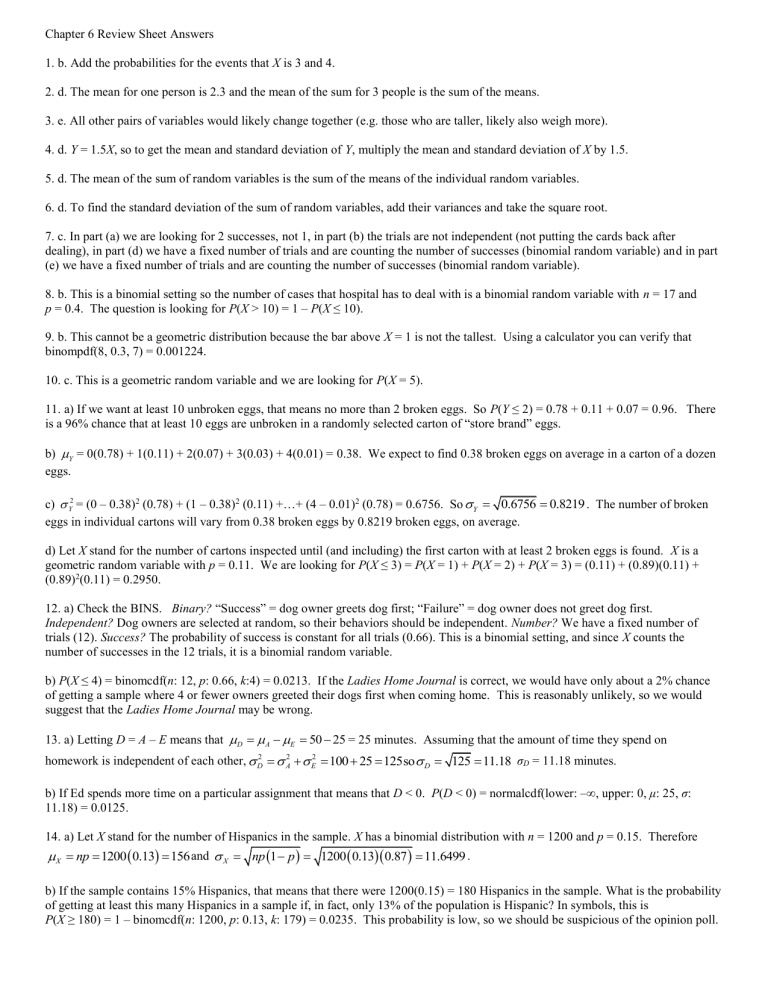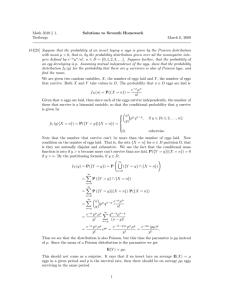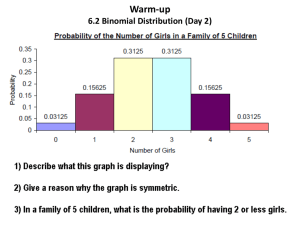Chapter 6 Review Sheet Answers - Statistics

Chapter 6 Review Sheet Answers
1. b. Add the probabilities for the events that X is 3 and 4.
2. d. The mean for one person is 2.3 and the mean of the sum for 3 people is the sum of the means.
3. e. All other pairs of variables would likely change together (e.g. those who are taller, likely also weigh more).
4. d. Y = 1.5
X , so to get the mean and standard deviation of Y , multiply the mean and standard deviation of X by 1.5.
5. d. The mean of the sum of random variables is the sum of the means of the individual random variables.
6. d. To find the standard deviation of the sum of random variables, add their variances and take the square root.
7. c. In part (a) we are looking for 2 successes, not 1, in part (b) the trials are not independent (not putting the cards back after dealing), in part (d) we have a fixed number of trials and are counting the number of successes (binomial random variable) and in part
(e) we have a fixed number of trials and are counting the number of successes (binomial random variable).
8. b. This is a binomial setting so the number of cases that hospital has to deal with is a binomial random variable with n = 17 and p = 0.4. The question is looking for P ( X > 10) = 1 – P ( X ≤ 10).
9. b. This cannot be a geometric distribution because the bar above X = 1 is not the tallest. Using a calculator you can verify that binompdf(8, 0.3, 7) = 0.001224.
10. c. This is a geometric random variable and we are looking for P ( X = 5).
11. a) If we want at least 10 unbroken eggs, that means no more than 2 broken eggs. So P ( Y ≤ 2) = 0.78 + 0.11 + 0.07 = 0.96. There is a 96% chance that at least 10 eggs are unbroken in a randomly selected carton of “store brand” eggs. b)
= 0(0.78) + 1(0.11) + 2(0.07) + 3(0.03) + 4(0.01) = 0.38. We expect to find 0.38 broken eggs on average in a carton of a dozen
Y eggs. c)
2
Y
= (0 – 0.38) 2 (0.78) + (1 – 0.38) 2 (0.11) +…+ (4 – 0.01) 2 (0.78) = 0.6756. So
Y
0.6756
0.8219
. The number of broken eggs in individual cartons will vary from 0.38 broken eggs by 0.8219 broken eggs, on average. d) Let X stand for the number of cartons inspected until (and including) the first carton with at least 2 broken eggs is found. X is a geometric random variable with p = 0.11. We are looking for P ( X ≤ 3) = P ( X = 1) + P ( X = 2) + P ( X = 3) = (0.11) + (0.89)(0.11) +
(0.89) 2 (0.11) = 0.2950.
12. a) Check the BINS. Binary?
“Success” = dog owner greets dog first; “Failure” = dog owner does not greet dog first.
Independent?
Dog owners are selected at random, so their behaviors should be independent. Number?
We have a fixed number of trials (12). Success?
The probability of success is constant for all trials (0.66). This is a binomial setting, and since X counts the number of successes in the 12 trials, it is a binomial random variable. b) P ( X ≤ 4) = binomcdf( n : 12, p : 0.66, k :4) = 0.0213. If the Ladies Home Journal is correct, we would have only about a 2% chance of getting a sample where 4 or fewer owners greeted their dogs first when coming home. This is reasonably unlikely, so we would suggest that the Ladies Home Journal may be wrong.
13. a) Letting D = A – E means that
D
A
E
50 25 = 25 minutes. Assuming that the amount of time they spend on homework is independent of each other,
2
D
2
A
2
E
100 25 125so
D
125
11.18
σ
D
= 11.18 minutes. b) If Ed spends more time on a particular assignment that means that D < 0. P ( D < 0) = normalcdf(lower: –∞, upper: 0, μ : 25, σ :
11.18) = 0.0125.
14. a) Let X stand for the number of Hispanics in the sample. X has a binomial distribution with n = 1200 and p = 0.15. Therefore
X np
156 and
X
np
1
p
11.6499
. b) If the sample contains 15% Hispanics, that means that there were 1200(0.15) = 180 Hispanics in the sample. What is the probability of getting at least this many Hispanics in a sample if, in fact, only 13% of the population is Hispanic? In symbols, this is
P ( X ≥ 180) = 1 – binomcdf( n : 1200, p : 0.13, k : 179) = 0.0235. This probability is low, so we should be suspicious of the opinion poll.










